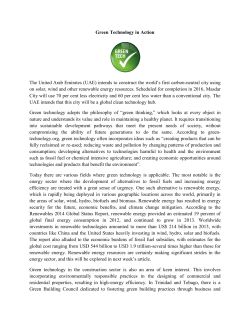
Renewable Energy in the Manufacturing Sector
Webina r 18 March 2015 Renewable Energy in the Manufacturing Sector: The Next Frontier RE for Productive Uses in Africa Linus Mofor Africa n Clima te Policy Centre UNECA, Addis Aba ba , Ethiopia Outline • About the UN Economic Commission for Africa (UNECA) • Current uses of renewables for productive applications in Africa; some sectoral examples • Opportunities going forward – the African structural transformation agenda • Conclusion – key messages About UNECA • The only UN institution mandated to operate at the regional and subregional levels to harness resources and bring them to bear on Africa's priorities • Champions the African structural transformation and green growth agenda • Various divisions, including Special Initiatives (SID) • SID: ACPC – Hub for demand-led knowledge generation on climate change in Africa AMDC, NTI, GENR RE for Productive Uses in Africa Current Use of RE for Productive Applica tions in Africa • 6 Mtoe (252 PJ) in agricultural sector • 22 (924 PJ) Mtoe in services sector – mainly telecoms Source: IEA Africa Energy Outlook 2014 Cement Cement 134,811 ktonnes cement (2009) Energy Requirements Dry processing: 2.93 – 4.6 GJ/tonne clinker Wet processing: 5.86 – 6.28 GJ/tonne clinker Technology mix in Africa: 67% dry processing; 24% wet processing; 9% semi-dry processing with average heat requirement of 3.82 GJ/tonne Renewable energy use Up to 40% of coal and HFO consumption can be substituted and substitution with waste biomass and dedicated biomass potential 50% or more of the electricity used can be substituted by renewable electrification in large-scale, grid- connected installations that ensure reliability of supply. Aluminium Production 1,876 ktonnes (2009) Energy Requirements Electricity: 13.5 – 17 MWh/tonne Al Natural gas or fuel oil: 2.5 MJ/kg Al E.g. South Africa and Nigeria use coal-based and gas-based power Cameroon uses hydropower Renewable energy use More than 50% of the electricity requirements of aluminium and substitution potential smelting in Africa is already met with large-scale hydropower. Potential for small-scale, off-grid renewable electrification for non-process electricity in fossil-based smelters in South Africa Appreciable volumes of biomass would need to be sourced and transported to the smelter as a replacement fuel for furnaces Sugar Production 99,074 ktonne sugar cane (2009) Energy Requirements 0.5 – 0.87 GJ/tonne Renewable energy use • Bagasse use can be optimised in co-generation facilities to and substitution meet 100% of energy demand and provide export potential electricity • Solar thermal technologies for air and boiler water preheating or steam generation could potentially be applied to this sector • Small-scale, off-grid renewable electrification may be applied in this sector and represents a substitution potential Bagasse co-generation plant in Kenya Other examples in Mauritius, Swaziland, Uganda, etc RE in Industry Opportunities Going Forwa rd in Africa African Structural Transformation Agenda • New dynamic for structural transformation and green growth in Africa – greening Africa’s industrialisation • Offers huge opportunities for RE use in industry • How to best use Africa’s biomass resources for this? • But: Energy efficiency in industry must be addressed Need increased awareness of opportunities and business cases Above all, need policies and incentives to mainstream low-carbon energy systems in the industrialisation agenda Best opportunities in agro processing and mining Across the agro processing sector huge potential for energy from residues in unutilised Conclusion Key Messages • Large potential across Africa for renewable energy to substitute for fossil-based energy in productive sectors such as agro-processing, as well as heavy energy-use sectors, such as mining, cement and aluminium production • However, estimating the potential for renewable energy substitution is not only industry-specific, but also highly site-specific, requiring knowledge of the energy requirements as well as the availability of renewable resources at each particular industrial location • Heavy industries, such as aluminium and cement production, are better suited to grid-connected renewables • Hydropower or large biomass facilities preferable for heavy and continuous power demand from large industries to avoid resource and power-output variability • Governments need to provide the right framework to accelerate the transition to use of renewable power in the heavy industries - some of which are currently benefitting from heavily susidised conventional electricity • Although the supply of energy from the grid in many African countries is already dominated by hydropower, smaller-scale generation facilities show great potential to produce local, off-grid renewable energy supply for productive uses, especially in the agricultural sector • The potential of the agro processing and forestry sectors is highly under-utilised • The African structural transformation and green growth agenda provides substantial opportunities in the agro and mining sectors • This needs strong policy support and promotion of best practices Tha nk you www.uneca.org Lmofor@uneca.org
© Copyright 2025













